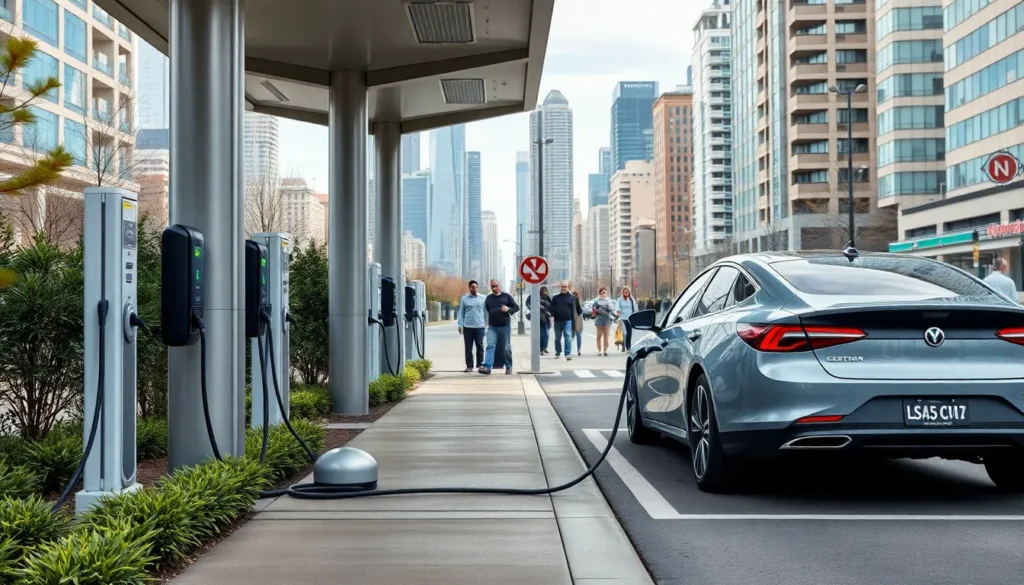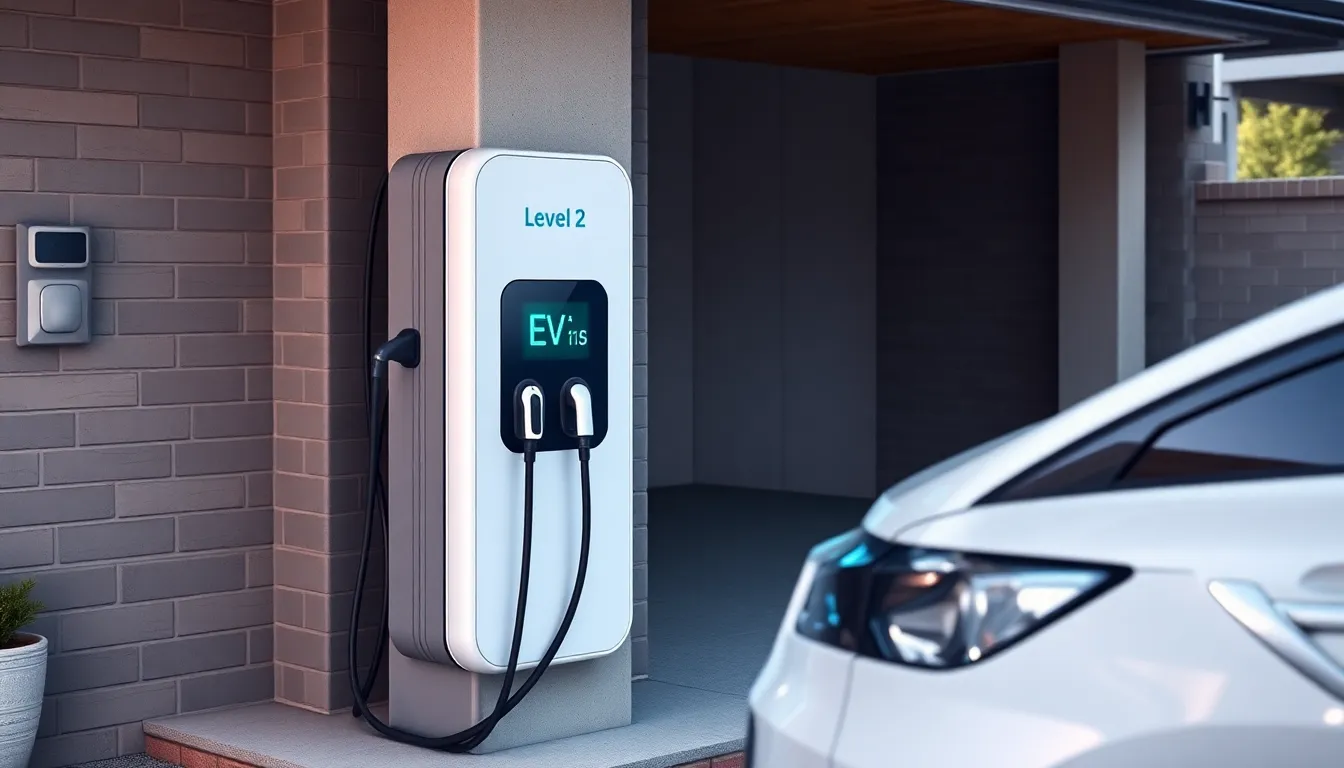In a world where smartphones and electric vehicles are practically extensions of ourselves, the need for charging stations has never been more critical. Imagine a life where your devices are always powered up, ready to tackle whatever the day throws at you. Setting up a charging station isn’t just a convenience; it’s a lifestyle upgrade.
Overview of Charging Station Setup
Charging stations play a crucial role in maintaining the power levels of devices like smartphones and electric vehicles. Setup involves several key components that ensure efficiency and accessibility.
Location needs careful consideration. Placing a charging station within easy reach of users maximizes convenience and ensures frequent use. Visibility also matters; positioning the station in a well-lit area encourages utilization.
Power source selection impacts functionality significantly. Using a reliable power supply, such as a dedicated circuit, maximizes charging speed and reduces downtime. Safety features must be prioritized; incorporating surge protectors and circuit breakers protects both users and equipment.
Installation requires professional assistance. Qualified electricians ensure compliance with local regulations and proper grounding, minimizing installation risks. Choosing the right type of charging connector enhances compatibility with various devices, ensuring flexibility.
User interface considerations improve the overall experience. Clear instructions and user-friendly displays facilitate ease of use. Payment options should also be simplified, offering multiple methods like credit cards or mobile payment apps.
Regular maintenance is essential for optimal performance. Scheduling routine checks can identify issues before they escalate, keeping stations functional. Keeping track of usage data helps in understanding user patterns, leading to better service features in the future.
Each component of the charging station setup contributes to its effectiveness. Understanding these elements ensures users enjoy seamless charging experiences, enhancing their daily routines.
Types of Charging Stations
Various types of charging stations cater to different needs and preferences. Understanding these options helps in making informed decisions for charging solutions.
Level 1 Charging Stations
Level 1 charging stations use standard 120-volt outlets. They provide the slowest charging speeds, typically adding about 4 to 5 miles of range per hour. Perfect for overnight charging, these stations are often found in residential settings. Owners can simply plug in their electric vehicles (EVs) at home without additional equipment. Durability and accessibility make Level 1 stations a practical entry point for new EV users.
Level 2 Charging Stations
Level 2 charging stations operate on 240 volts. Capable of delivering around 25 to 30 miles of range per hour, they are ideal for both home and public use. These systems require professional installation and are often placed in garages, parking lots, and commercial areas. Users benefit from faster charging times compared to Level 1 stations. Enhanced speed allows for quick top-ups, suitable for those who are frequently on the go.
DC Fast Charging Stations
DC fast charging stations offer rapid charging capabilities. Operating at 400 volts or higher, they can supply up to 80% charge in about 30 minutes. Often located along highways, these stations accommodate long-distance travel. Drivers can enjoy significant range boosts without long waiting periods. Generally operated by various charging networks, access may require specific memberships or payment methods.
Key Components of Charging Station Setup
Setting up a charging station requires careful consideration of several key components. Each component plays a vital role in ensuring efficient and reliable performance.
Charging Equipment
Charging equipment includes various types of plugs and cables, which must match the devices that users will be charging. Level 1 chargers typically use standard 120-volt household outlets, providing convenience for home use. Level 2 chargers, found in both residential and commercial settings, operate on 240 volts and significantly reduce charging time. DC fast chargers cater to electric vehicles needing quick top-ups. Ensuring compatibility with different vehicle models and devices enhances the overall charging experience for users.
Electrical Requirements
Proper electrical requirements form the backbone of a successful charging station setup. Sufficient amperage must be available to support the intended charging speed. For Level 2 chargers, circuits often require dedicated 40- to 60-amp breakers. Qualified electricians should evaluate the existing wiring to ensure it meets local codes. Compliance with regulations ensures safety and prevents overloading, allowing the station to perform optimally under varying load conditions.
Site Considerations
Site considerations influence the charging station’s accessibility and user experience. Location selection plays a crucial role in visibility and convenience; placing stations near high-traffic areas encourages usage. Adequate space for vehicle maneuvering should be factored in to enhance the user experience. Weather-related protections, like coverings or enclosures, help maintain equipment functionality. Additionally, ensuring proper signage to direct users can further improve the overall charging station setup.
Installation Process
Setting up a charging station involves precise steps to ensure it meets user needs and adheres to regulations.
Planning and Permitting
Before any installation begins, thorough planning is necessary. Users must identify optimal locations that offer visibility and convenience. Local regulations often require permits for electrical work, so checking with local authorities on requirements is essential. This ensures compliance with zoning laws and safety codes. Engaging with an experienced contractor simplifies the permitting process further. They can navigate the paperwork efficiently and expedite approvals.
Wiring and Equipment Installation
Electrical wiring for charging stations requires careful attention. Sufficient amperage must exist to support the charging speeds needed. Equipment should be compatible with specific charging needs, whether for Level 1, Level 2, or DC fast chargers. Professionals typically handle installation to meet code compliance and safety regulations. Grounding and surge protection systems are also critical components. Proper installation ensures reliability and minimizes potential hazards.
Testing and Commissioning
After installation, rigorous testing guarantees functionality and safety. Each charging station must undergo checks for electrical connections and performance to ensure optimal operation. Commissioning typically involves verifying that the charging speed aligns with specifications. User interfaces also undergo assessment to confirm effectiveness and clarity. Following thorough testing, documentation of operational data assists in continuous performance monitoring.
Conclusion
Establishing a well-thought-out charging station setup is crucial in today’s tech-centric world. It not only enhances convenience but also ensures that devices are always ready for use. By paying attention to location, power sources, safety features, and user interface, individuals can create a seamless charging experience.
Choosing the right type of charging station based on specific needs is essential. Whether it’s a Level 1, Level 2, or DC fast charger, each option serves different purposes. Proper installation and regular maintenance further contribute to optimal performance and user satisfaction.
Ultimately, investing in a reliable charging station setup is about embracing a lifestyle that prioritizes connectivity and efficiency. With the right approach, users can enjoy the benefits of being powered up and ready to go at all times.














